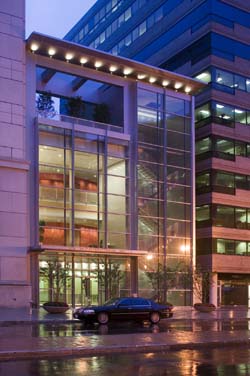- The experience of feeling around in the dark for a light switch is not an uncommon one, even with the somewhat well-established standard of placing this critical fixture immediately inside the door on the interior wall of a room. When the switch is in this place, very little thought goes into illuminating a room. However, place the switch just a little higher or lower than the standard height, or worse, install it on a wall outside a room, and mayhem ensues. Suddenly the almost involuntary act of turning on a light becomes a conscious effort, and the room design is subject to scrutiny.
RTKL launched its own voice, data, audiovisual and security systems design division in 1999, making it possible for architecture and engineering teams to work side by side with designers of an increasingly important technology infrastructure such as at the Inter-American Development Bank Auditorium and Conference.
In order for control of audiovisual systems to approach the intuitive nature of a light switch, a significant task lies ahead-a task which will very much determine the future of the industry as a whole. Except in this case, the mere placement of a control device is only one step in the process. End-users are presenting a seemingly infinite array of devices and manners in which they will access their systems, whether it's a wireless web tablet, a fixed panel at a lectern or a hand-held bluetooth device. And that's just the hardware part of the equation. Programming a GUI which suits the needs and skill level of a client is an activity that requires an increasing amount of time and resources, and this fact is indicative of a larger evolution at work.
"Clients want a sophisticated, standardized user interface across their enterprise, and when I say sophisticated I mean it might be very complex underneath the hood, but they want it very simple to the user," observed Scott Walker, principal with Waveguide Consulting in Atlanta, GA. "At this point, if one is not defining that user interface as part of a design exercise, and it's only coming to light in the last stages of a project, the owner is probably not going to be very happy."
After realizing that specifying the many requirements for the control and DSP programming elements of a system took almost as much time as it did to produce the desired end result itself, Waveguide brought programming in house with the creation of its brainwave division and correlative firstwave ongoing technology management division three years ago. Today the firm has five full-time software programmers on staff in addition to its stable of AV system designers who handle DSP programming for the projects they develop.
"After only three years of doing this, 40 percent of our company is in the software and ongoing support business," Walker said. Currently, Waveguide handles the programming on about two thirds of its projects. "What we're finding is that having programmers sit in on our design meetings early in the project and thus influencing that design all the way through the process makes us better system designers. It's about lengthening the time that software is thought about on a project in order to determine which problems we are going to solve with hardware and which problems are we going to solve with software."
Taking on the responsibility of writing and owning the software means that all the tough decisions about how a system is actually going to operate are made early on, as opposed to leaving the functionality up to an integrator that may join a project team three years into the process. But early involvement means long-term involvement, Walker emphasized, saying that companies interested in providing programming services will also have to think about ongoing support. "You can't write software and then walk away from the job. It's going to stay with you," he said.
Even support is headed in a software direction. Many times when a client makes a service request they ask for new software features for their existing hardware infrastructure, rather than seeking new boxes or repairs to equipment. This a clear reflection of the shift away from margins being made in box sales-an evolution which occurred in the IT industry a decade ago.
"The model has changed in that world to where it's now consulting, solutions, provision of integration, application, and by the way we'll provide you the boxes you need to make this all happen," noted David Labuskes, RCDD/LAN, CSI, vice president and director of the Special Systems Design Group for RTKL. "Those who didn't make the change are no longer in business, and if you apply that model to the AV integrator business, they have to either change or perish."
RTKL launched its own voice, data, audiovisual and security systems design division in 1999, making it possible for architecture and engineering teams to work side by side with designers of an increasingly important technology infrastructure. Today, RTKL has found that technological considerations may even influence the site selection process, as connectivity becomes a factor in determining the appropriateness of a location. "If you have the most beautiful landmark building in a city, but it will only support T1 access to the internet, that should disqualify that space, and it does nowadays," Labuskes said.

Yet another model that is evolving is that of the end-user AV department, which became a threat to integration companies originally as a result of economic considerations, but has since become a common solution to what many organizations perceive as a deficiency in quality in the industry. "They feel they could do the work better themselves," said Mario Maltese, CEO of Audio Visual Resources (AVR) an AV design/build company in Williston Park, NY. To combat the perception of inadequate standards for a job well done, Maltese led his company through the ISO9001:2000 certification process, and has maintained that highly esteemed credential for three years.
Looking to other industries for examples of quality standards, Maltese wrote a book proposing an AV9000 standard, and his InfoComm course on the topic has become very popular in recent years. The benefits of ISO:9001 certification are more than cosmetic, Maltese pointed out. By following the quality monitoring processes prescribed by the certification, companies become more efficient and improve their profits.
"You cannot beat the economics of doing things right the first time," Maltese said. Companies that do not monitor their cost of quality typically lose 30 percent of their revenue to drains like last-minute shipping and customer concessions. "That's where you hear integrators lamenting the fact that they're incredibly busy and they've increased their sales by 30 percent, but they're not making any money," Maltese described. "Their growth is just covering their losses. Those are the companies that go out of business when the market goes down."
"It's a paradigm shift for a company," Maltese said. "You're not there just to get the job done, you're there to constantly improve what you're doing. The focus changes from the individual to the system. The stress drops, and there's no such thing as having to motivate your employees. They're motivated, just get out of their way."










